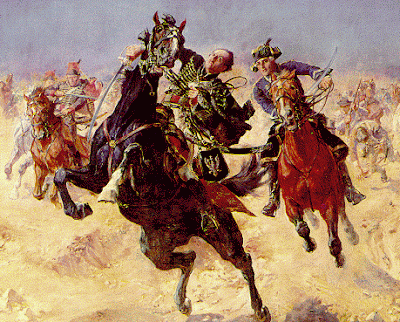Birthplace: Warka-Winiary, Poland
Died: 15 October 1779
Best Known As: Polish general of the Revolutionary War
Casimir Pulaski was a Polish military officer who fought on the side of the American colonists against the British in the Revolutionary War. The "father of the American cavalry," he was mortally wounded during the 1779 siege of Savannah, Georgia. Pulaski was known throughout Europe for his savvy strategies against Russian invaders, particularly in Berdichev (1768) and Czestochowa (1770).

When Poland was partitioned by Prussians and Austrians, Pulaski fled to Paris, where he met Benjamin Franklin (1776). Enlisted to help the American colonists fight the British, Pulaski arrived in Philadelphia in 1777 with a letter of introduction from Franklin to George Washington. Within six months Pulaski had shown his mettle on battlefields at Brandywine and Germantown. He was promoted to brigadier general and named chief of the cavalry; he resigned six months later because of friction with fellow soldiers, and went on to form a cavalry and infantry unit that was known as Pulaski's Legion. Sent to the south, he fought at Charleston and then at the siege of Savannah (23 September - 18 October), where he was wounded by grapeshot on 9 October 1779. He was sent to Charleston aboard the brigantine Wasp, but he died on October 15th that year and was buried at Greenwich Plantation, Georgia. He was exhumed in 1853 and his remains were placed in the cornerstone of the Pulaski Monument in Savannah. Restoration on the monument in 1996 led to another exhumation. DNA tests on the remains concluded that they were, indeed, most likely Pulaski's.

Early biographies have Pulaski's birthdate as March 1747, but recent discoveries of Warka baptism records have revised it... For many years it was thought that Pulaski died 11 October 1779 aboard the Wasp and was buried at sea... In the U.S. 11 October is traditionally proclaimed General Pulaski Memorial Day by the president.

Casimir Pulaski was a Polish military officer who fought on the side of the American colonists against the British in the Revolutionary War. The "father of the American cavalry," he was mortally wounded during the 1779 siege of Savannah, Georgia. Pulaski was known throughout Europe for his savvy strategies against Russian invaders, particularly in Berdichev (1768) and Czestochowa (1770). When Poland was partitioned by Prussians and Austrians, Pulaski fled to Paris, where he met Benjamin Franklin (1776). Enlisted to help the American colonists fight the British, Pulaski arrived in Philadelphia in 1777 with a letter of introduction from Franklin to George Washington.

Within six months Pulaski had shown his mettle on battlefields at Brandywine and Germantown. He was promoted to brigadier general and named chief of the cavalry; he resigned six months later because of friction with fellow soldiers, and went on to form a cavalry and infantry unit that was known as Pulaski's Legion. Sent to the south, he fought at Charleston and then at the siege of Savannah (23 September - 18 October), where he was wounded by grapeshot on 9 October 1779. He was sent to Charleston aboard the brigantine Wasp, but he died on October 15th that year and was buried at Greenwich Plantation, Georgia. He was exhumed in 1853 and his remains were placed in the cornerstone of the Pulaski Monument in Savannah. Restoration on the monument in 1996 led to another exhumation. DNA tests on the remains concluded that they were, indeed, most likely Pulaski's.
Extra credit: Early biographies have Pulaski's birthdate as March 1747, but recent discoveries of Warka baptism records have revised it... For many years it was thought that Pulaski died 11 October 1779 aboard the Wasp and was buried at sea... In the U.S. 11 October is traditionally proclaimed General Pulaski Memorial Day by the president.